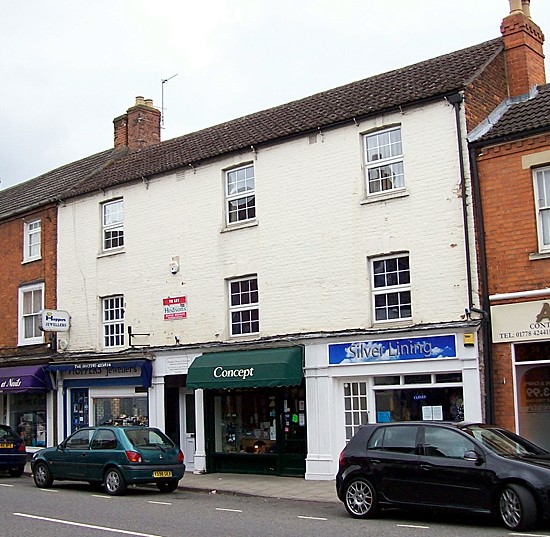|
The Six Bells
No 35 North Street was used as a public house for almost 200 years and was known as the Six Bells. There were stables and a paddock at the rear and the business was also licensed to hire horses and traps.
The premises next door when this picture was taken circa 1890 were occupied by William Henry Redshaw, a well known local photographer, and many examples of his work survive. The young man pictured with the pony and trap is thought to be his son while a frame containing examples of his studio's portraiture hangs on the wall outside the shop.
During the early years of the 19th century, the Six Bells became one of the main venues in the town, along with the Angel Inn, as is was then, the Bull Inn, now the Burghley Arms, and the Nag’s Head. This will be difficult to believe because the Six Bells was known in later years simply as a town centre public house, a reputation that belies the importance it once enjoyed and although now closed since 1983, the building survives as three small shops making its original role seem even more unlikely yet two centuries ago it had a frontage of over 40 feet on North Street and extensive grounds at the rear. The Six Bells dates from the mid-18th century, the name giving an indication of the date because it most certainly has ecclesiastical connections and usually associated with the number of bells in the nearby church tower and a peal of six bells were installed at the Abbey Church in 1729. There is a possibility that the men who built the inn influenced its name after hearing the nearby bells or it may have provided accommodation for church visitors or even for officials who worked there. It was certainly a substantial business and we have an indication of its size from descriptions of the property included in public notices when it came up for sale in 1848. Inside there was a spacious dining room, a large clubroom, four sitting rooms, several bedrooms, two bars, kitchen and other offices while outside there were outhouses, granaries, stabling for 30 horses, a coach house, a yard and gardens covering almost one acre, a paddock known as Home Close of almost 1½ acres. The inn also had its own brewery recently fitted with the latest equipment and capable of handling three quarters of malt at a time with a copper capable of holding 300 gallons of beer and storage facilities for a further 2,000 gallons. “The property is most eligibly situated”, said the notice, “a first rate trade is done at the house. Four fairs and the pig market are held on the premises.” Pink’s Vans, a local contracting company, also used the inn as their headquarters, moving goods in transit for the London and North Western Railway station at Peterborough because it was to be another twelve years before the railway line reached Bourne. Another carrier, Ashby’s Van, plied between the Six Bells and London three days a week and with a waggon once a week. It was then a very busy inn and one that also became a centre of information and gossip and therefore a popular haunt of local businessmen. Annual meetings and dinners of several organisations were also held there, notably the Bourne and District Ploughing Society and the Odd Fellows Lodge used the clubroom as their headquarters. Auctions of land and property were held there and the stables were also used for keeping horses by visiting fairs and circuses and the paddock as the annual venue for the Bourne Fatstock Show. Joshua Lincoln, who was landlord in 1842, also introduced annual balls and card assemblies, mixed occasions that allowed the men to play cards and the ladies to dance, the proceedings to begin at eight o’clock in the evening and continue until the early hours with the Bourne Band in attendance to provide the music, tickets 2s. 6d. each [£10 at today’s values]. There was a succession of landlords over the years, colourful characters who made their mark in the life of the town, among them William Roberts, aged 52, who fell downstairs in May 1825 and died soon afterwards. It was thought that he might have been drunk and had fractured his skull in the fall but a doctor who was called said that he had died of apoplexy, a popular conclusion at the time before the present advances in medical knowledge. The Town Hall built in 1821 soon became a venue for balls organised by the clergy and the landed gentry but this failed to dent the popularity of the Six Bells although bookings were seriously affected with the opening of the Corn Exchange in 1870, designed not only for trade but also with a public hall for musical and other entertainments that could easily accommodate 500 people, a situation that continues to this day. By the 20th century, the motor car had replaced horse drawn traffic and the stables became redundant. The Six Bells had become a town centre public house, particularly popular with staff and workers at the BRM workshops in Bourne and was therefore the scene of many celebrations when their cars won at international events. Dick Salmon, aged 88, one of the company’s leading motor racing mechanics, remembers those days with nostalgia. “We had some great times”, he said. “Some of the staff lodged at the pub and many of us went there every day for our lunch.”
REVISED MARCH 2014 See also Inns and other hostelries
Go to: Main Index |



